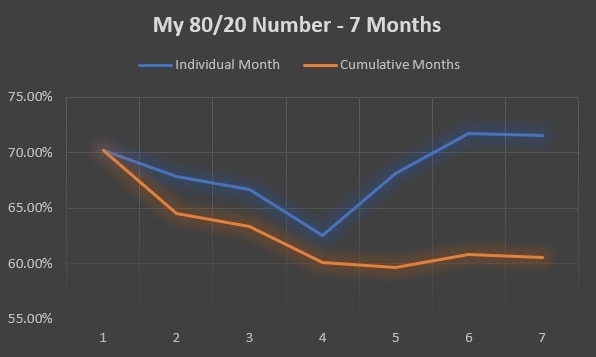
It is commonly said that we wear 20 percent of our clothes 80 percent of the time.
The concept is taken from the Pareto Principle, which claims that 80 percent of your results come from 20 percent of your efforts. Here are some examples:
- 80% of your sales come from 20% of your clients
- 80% of car accidents are caused by 20% of the drivers
- 80% of views on this website come from 20% of the articles
- Etc…
So… what about you and your closet? Do 80% of your outfits come from 20% of your clothes?
Fortunately for you… you are innocent until proven guilty. The problem is, it is quite time consuming to actually prove that you wear 20 percent of your clothes 80 percent of the time. You may suspect that you do, but most people won’t bother to actually find out.
And that’s totally fine. The point most people are making is that we spend too much money on clothes when, really, we already have all the clothes we need in our closets. You could (and should!?) save that money and invest it in yourself in other ways.
Still, I couldn’t help myself. I had to find out if I was guilty of wearing 20 percent of my clothes 80 percent of the time. On June 15, 2019, I decided to find out for myself, on myself, and to share my results with the world.
How Does My 80/20 Wardrobe Experiment Work?
I have written and spoken about this in great detail in my other update articles and videos. You can read all about the experiment setup and process in this article: Is the 80/20 Rule for Clothes Real (1-Month Self-Study). To quickly summarize for you new readers:
- I itemized my entire wardrobe into an Excel spreadsheet
- I found out that I had 96 articles in my wardrobe
- I calculated 20% of 96 to be 19.2, which becomes 19 when rounded
- I kept track of everything I wore, every day, for the last 7 months
- I calculated how often I wore the top 19 articles of my wardrobe
That’s it. Nice and easy. The setup took some time, but the daily input is pretty easy and quick.
I Had My Birthday During Month 7!

In the first 5 months of this experiment nothing changed with respect to my wardrobe.
In the 6th month I found a pair of gloves hidden in a box which I had forgotten to include in my inventory. I added it to my Excel spreadsheet and recalculated everything. Fortunately, nothing changed as 20% of 97 (96 + 1) articles of clothes is still 19 when rounded.
In the 7th month I had another change… I celebrated my birthday and was gifted a robe by my girlfriend’s mother! It is an AWESOME present, I love it, and I wear it often… but…
It left me with a logistical question to answer. By adding one more item to my wardrobe, I went from 97 items to 98 items. This means that 20% of my wardrobe would change from 19.4 articles to 19.6 articles.
Thanks to the power of rounding, this changes my 80/20 number from 19 items to 20 items! This change would cause a lack of consistency between months and make it trickier to compare my monthly 80/20 numbers
To solve the issue, I threw out a pair of socks that I had not worn at all over the last 7 months. This keeps the total number of articles in my wardrobe the same and the consistency of my monthly 80/20 number intact.
What Are the Results After Seven Months?
So, how did my numbers look after 7 months? I have broken it down into some charts and graphs. Let’s see how I did:
My 80/20 Rule Number for Each Individual Month:
| Month | 1 | 2 | 3 | 4 | 5 | 6 | 7 |
| Individual Month | 70.21% | 67.83% | 66.67% | 62.56% | 68.16% | 71.76% | 71.58% |
My 80/20 Rule Number for Each Cumulative Month:
| Month | 1 | 1-2 | 1-3 | 1-4 | 1-5 | 1-6 | 1-7 |
| Cumulative Months | 70.21% | 64.52% | 63.34% | 60.13% | 59.63% | 60.75% | 60.55% |
Graph of Above Data:

So, over the course of seven cumulative months, I wore 20% of my wardrobe 60.55% of the time!
It’s not 80%, but it is still a disproportionately frequent amount of time to be wearing the same 19 things over-and-over again.
It is also worth pointing out that my 80/20 number dropped from 70% in the 1st month to 60% in the 4th month. Since then, my 80/20 number has remained a pretty constant 60% during months 4, 5, 6, and 7.
Things are much different when you only look at the individual months. In month 7, for example, I wore 20% of my clothes almost 72% of the time. The same thing happened in the 6th month. In general, my 80/20 number on a monthly basis is higher and fluctuates much more than over longer periods of time.
Statistically, this makes sense, as there is more variance in the short term and things typically average out over the long term.
Speaking more practically, I believe that the weather plays a role in this. The weather has been cold and windy, so I wear my cold-weather clothes pretty much every day. I suspect that the same would be true in the middle of summer.
When the seasons change, however, I would expect my 80/20 number to be smaller as there are more opportunities to wear different outfits, and that seems to be the case with my data. Over time, however, when all averaged together, it seems like I wear 20% of all of my wardrobe about 60% of the time.
The Percent of My Total Wardrobe Worn for Each Individual Month:
| Month | 1 | 2 | 3 | 4 | 5 | 6 | 7 |
| Individual Month | 53.61% | 54.64% | 56.70% | 68.04% | 60.82% | 65.98% | 74.23% |
The Percent of My Total Wardrobe Worn for Each Cumulative Month:
| Month | 1 | 1-2 | 1-3 | 1-4 | 1-5 | 1-6 | 1-7 |
| Cumulative Months | 53.61% | 61.86% | 71.13% | 77.32% | 80.41% | 84.54% | 87.64% |
Graph of Above Data:

After seven months, I have used 87.64% of my entire wardrobe!
I consider this a pretty nice result. It means that I use most of the things that I own and that I have not been too wasteful in the clothes that I have acquired over the years. Some items yet unused include:
- a specialty water-proof water-sport shirt
- my swim cap
- my dress shoes
- my dress pants
- a pair of shorts that do not fit me anymore due to losing weight
- my specialty hiking pants
I hope to use the hiking and sporting items, as I love these activities quite a bit. This is actually a nice insight for me that I should probably plan some more outdoor activities ASAP! Either that, or find more occasions which require dress pants and shoes. Personally, I will stick with the hiking and outdoor sports!
What Would It Take for Me to Get to 80%?
I have discovered that I wear 20% of my clothes (19 articles) 60.55% of the time over a seven-month period. Kewl. The next question I have is:
1. What percentage of my wardrobe do I currently wear 80% of the time?
For fun, I calculated this, too. As it turns out, I wear 38% (37 articles) of my clothing 80.44% of the time.
Let’s review this in a chart:
| Number of articles out of total (97) | 19 | 37 |
| Percent of times worn (100%) | 60.55% | 80.44% |
So, the first 19 articles were work about 60% of the time.
The next 18 articles were only worn about 20% of the time. And it only gets worse from here.
2. How many additional articles of clothing would I need to have in my wardrobe to actually have an 80/20 ratio?
We just found out that I wore 37 articles of clothing 80.44% of the time, and that those 37 articles constituted about 38% of my total wardrobe.
What if those 37 articles were 20% of my wardrobe?
If that were true, then I would have 189 articles of clothing in my closet. That’s an additional 92 pieces which would be lying there unused in addition to my current wardrobe!
Is this possible? Sure, of course it is. To me, however, it sounds totally absurd and I doubt (hope) that this is never the case for me. It seems totally wasteful in my eyes. Still, I could see how it might be possible for some people.
What Does My 80/20 Number Mean?
I have learned much after seven months of this experiment. First and foremost, I think I understand why I could not find any data on this during my initial searching eight months ago… it is quite the commitment to collect and analyze all this data!
I also suspect that the normal person will NOT actually wear 20% of their clothes 80% of the time. Based on the numbers I am seeing in myself, it would require extreme selectivity of choice, or an extremely large wardrobe to actually achieve 80/20.
Still, I do suspect that the average person would get close to 80/20 and that they probably do have more clothes in their wardrobe than needed.
At the end of the day, that is what all of these articles are about: don’t waste your money on clothes you don’t need when you already have more than enough to cover your needs and wants in your wardrobe.
Save your money and/or reinvest it in yourself in more beneficial ways, such as:
- professional development
- continued education
- financial investing
- a hobby
- buying and reading books
- buying higher quality food
- playing Monopoly with real money (optional)
You get the idea…
My Fat, Broke and Stupid YouTube Video
As always, you can check out my Fat, Broke and Stupid YouTube Channel to hear me speak directly about this month’s 80/20 results. Click the link, or watch it here:
Remember to subscribe and hit the notification bell to be the first to see all of my update videos moving forward on this, and all of my other, experiments and challenges!
Would You Like to Try?
Are you curious to try this experiment out for yourself? If so, I have prepared a template based on the Excel spreadsheet I created for myself. You can download it here:
If you have any questions or need help getting set up, reach out to me on my contact page. I would be thrilled to get you started on your own 80/20 self-study!

